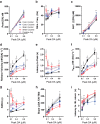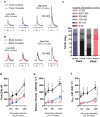Terminal Dopamine Release Kinetics in the Accumbens Core and Shell Are Distinctly Altered after Withdrawal from Cocaine Self-Administration
- PMID: 27752541
- PMCID: PMC5052666
- DOI: 10.1523/ENEURO.0274-16.2016
Terminal Dopamine Release Kinetics in the Accumbens Core and Shell Are Distinctly Altered after Withdrawal from Cocaine Self-Administration
Abstract
Repeated self-administration of cocaine is associated with impairments in motivated behaviors as well as alterations in both dopamine (DA) release and neural signaling within the nucleus accumbens (NAc). These impairments are present even after several weeks of abstinence from drug taking, suggesting that the self-administration experience induces long-lasting neuroplastic alterations in the mesolimbic DA circuit. To understand these changes at the terminal level, rats were allowed to self-administer either cocaine intravenously (∼1 mg/kg per infusion) or water to a receptacle (control) in 2-h sessions over 14 days, followed by 30 days of enforced abstinence. Fast-scan cyclic voltammetry was used to record real-time DA release in either NAc core or shell after electrical stimulations of the ventral tegmental area (VTA) in freely-moving animals. In controls, the kinetics of DA release in the core and shell strikingly differed, with shell displaying slower release and reuptake rates than core. However, cocaine experience differentially altered these signaling patterns by NAc subregion. In the shell, cocaine rats showed less sensitivity to the dynamic range of applied stimulations than controls. In the core, by contrast, cocaine rats displayed robustly reduced peak DA release given the same stimulation, while also showing slower release and reuptake kinetics. The differential effects of cocaine self-administration on terminal function between core and shell is consistent with a region-specific functional reorganization of the mesolimbic DA system after repeated exposure and may provide an anatomical substrate for altered cognitive function after chronic drug-taking and addiction.
Keywords: Michaelis–Menten; dopamine transporter; drug addiction; plasticity; ventral striatum; voltammetry.
Figures






Similar articles
-
Cocaine Self-Administration Experience Induces Pathological Phasic Accumbens Dopamine Signals and Abnormal Incentive Behaviors in Drug-Abstinent Rats.J Neurosci. 2016 Jan 6;36(1):235-50. doi: 10.1523/JNEUROSCI.3468-15.2016. J Neurosci. 2016. PMID: 26740664 Free PMC article.
-
One month of cocaine abstinence potentiates rapid dopamine signaling in the nucleus accumbens core.Neuropharmacology. 2016 Dec;111:223-230. doi: 10.1016/j.neuropharm.2016.09.006. Epub 2016 Sep 8. Neuropharmacology. 2016. PMID: 27616012 Free PMC article.
-
Rapid induction of dopamine sensitization in the nucleus accumbens shell induced by a single injection of cocaine.Behav Brain Res. 2017 May 1;324:66-70. doi: 10.1016/j.bbr.2017.02.018. Epub 2017 Feb 14. Behav Brain Res. 2017. PMID: 28223145 Free PMC article.
-
Extinction training regulates neuroadaptive responses to withdrawal from chronic cocaine self-administration.Learn Mem. 2004 Sep-Oct;11(5):648-57. doi: 10.1101/lm.81404. Learn Mem. 2004. PMID: 15466321 Free PMC article. Review.
-
Cocaine-induced metaplasticity in the nucleus accumbens: silent synapse and beyond.Neuropharmacology. 2011 Dec;61(7):1060-9. doi: 10.1016/j.neuropharm.2010.12.033. Epub 2011 Jan 11. Neuropharmacology. 2011. PMID: 21232547 Free PMC article. Review.
Cited by
-
Heterogeneous dopamine signals support distinct features of motivated actions: implications for learning and addiction.Learn Mem. 2018 Aug 16;25(9):416-424. doi: 10.1101/lm.047019.117. Print 2018 Sep. Learn Mem. 2018. PMID: 30115763 Free PMC article. Review.
-
Dopamine in the dorsal bed nucleus of stria terminalis signals Pavlovian sign-tracking and reward violations.Elife. 2023 May 26;12:e81980. doi: 10.7554/eLife.81980. Elife. 2023. PMID: 37232554 Free PMC article.
-
Chronic ethanol exposure increases inhibition of optically targeted phasic dopamine release in the nucleus accumbens core and medial shell ex vivo.Mol Cell Neurosci. 2017 Dec;85:93-104. doi: 10.1016/j.mcn.2017.09.007. Epub 2017 Sep 20. Mol Cell Neurosci. 2017. PMID: 28942046 Free PMC article.
-
Analysis of Evidence for the Combination of Pro-dopamine Regulator (KB220PAM) and Naltrexone to Prevent Opioid Use Disorder Relapse.EC Psychol Psychiatr. 2018 Aug;7(8):564-579. Epub 2018 Jul 30. EC Psychol Psychiatr. 2018. PMID: 30417173 Free PMC article.
-
Incubation of cocaine craving coincides with changes in dopamine terminal neurotransmission.Addict Neurosci. 2022 Sep;3:100029. doi: 10.1016/j.addicn.2022.100029. Epub 2022 Jul 14. Addict Neurosci. 2022. PMID: 36081573 Free PMC article.
References
-
- Aragona BJ, Cleaveland NA, Stuber GD, Day JJ, Carelli RM, Wightman RM (2008) Preferential enhancement of dopamine transmission within the nucleus accumbens shell by cocaine is attributable to a direct increase in phasic dopamine release events. J Neurosci 28:8821–8831. 10.1523/JNEUROSCI.2225-08.2008 - DOI - PMC - PubMed
Publication types
MeSH terms
Substances
Grants and funding
LinkOut - more resources
Full Text Sources
Other Literature Sources
Medical
